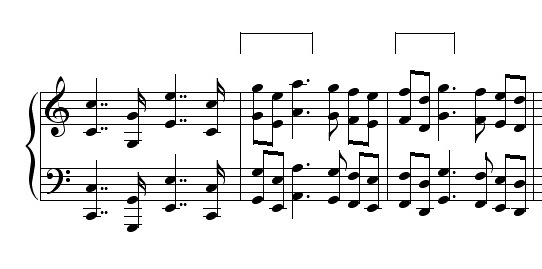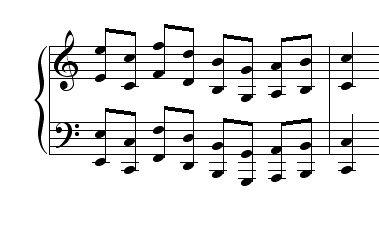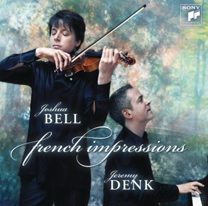In music, cause and effect are lovers, always meeting at night in remote nooks and gardens, where no one can see them. All we can do is gossip, speculate and murmur over our omelettes in the morning. They come out of their rooms, freshly showered, looking innocent enough, but you gaze enviously at the circles beneath their eyes.
Admittedly, there are simple things we like to think of as cause-and-effect. They are curriculum-friendly, unsexy. For instance (to name one of a thousand examples) in a baroque dance movement, the first half modulates tonic-dominant; the second half modulates back, dominant-tonic. What goes up must come down … etc. etc., the harmony sallies forth and then sallies right back home. But these patterns are conventions of form, conventions of speech: not events, but receptacles, like bookshelves. Their generic nature, their reproducibility, is useful (stackable), but not particularly interesting.
Here’s what I think is a really interesting example of music’s mysterious suggestion of cause and effect.
Mozart (K 521) begins with a leaping idea …

… in which I feel a delicious play of body and mind, coinciding with the leaping of the intervals: a genial germ of movement, of propelled energy. This energy rounds itself off, cleverly …

… with its completion, we know that it was just a fanfare. We’re back in the tonic. The piece has been announced. What is, now was, and it’s merrily off to the land of what-will-be.
As any theory professor or mildly educated musician will confirm, trickywicky Mozart has sneakilysnuck into this fanfare a bit of motivic development. As we bounce along, a little recurring idea stepladders down…

The motive is like a mercurial spirit, dancing within the confines of the phrase, but not exactly or totally subjected to it. The phrase is waiting for the motive; the motive is waiting for the phrase … they are partners in the discourse. The phrase needs something from the motive (that is, for the motive to end on C, to give it closure, a tonic-gasm); and the motive needs something from the phrase (attention, affection). (It’s just like a real-life relationship! Look forward to my self-help tome, How Mozartean Phrase Structure Can Help Your Marriage.)
OK, so meanwhile: after the fanfare, some outrageously charming stuff happens, yadda yadda yadda; and THEN, the fanfare comes back:

YOW! … look at that bottom voice … lulled by charm and humor and the pendulum of simple tonic and dominant, you may be shocked when, this time, a chromatic bassline attacks the diatonic melody; there is a flurry of reharmonization, a sudden tragic hue. (If the person playing primo is extremely self-involved, he/she may not notice at all, since it doesn’t affect his/her part. This is not recommended.)
Why does this bassline happen? What causes it?
It’s a why-less proposition, a thunderbolt. Or at least, its why can only be “understood” after the fact. For, out of these disturbed chromatic notes comes the most beautiful passage of the piece so far:
… and, with that, Mozart proves that an earthquake causes an ice cream sundae.
The lyrical passage somehow “needed” the previous dissonant interruption in order to come into existence, though it has almost nothing in common with it. Mozart stomps his foot, creates chromatic mess all over his diatonic cleanliness, and the mess is—who would have imagined?—just the fertilizer we needed for a beautiful flower to bloom.
(And—of course—what’s hidden in this flower? The new tender duet boasts the following:
which is just reshaping the main motive, backwards. The mercurial spirit of the piece makes a cameo appearance, lovingly, in a new guise, perhaps with a mustache, perhaps in drag?)
Mozart shrugs at commonsense. Why should a transition make sense, or at least the kind of sense you know? He follows a deep bass storm with its nemesis, a tender duet in the treble—strange couplings, sublime misdirection—from dark to light, abruptly, he builds a mysterious chain of cause.
And as a performer, I’d love to make clear to you (the listener, is that who you are out there in the dark beyond the footlights?) that this sequence of events both makes sense and doesn’t make sense, simultaneously: that it perches, dangerously, irreverently, on the precipice of illogic. I would like to imply, intimate, some chain of cause that I cannot state. Please blink, or gape, in confusion or delight. Just don’t look too closely at the circles under my eyes; me and the motive were up to no good all night long.
[By the way, I believe the term “tonic-gasm” was invented right here on Think Denk. Don’t you go stealing it, now.]





5 Comments
very sexy post jeremy 😛
If I use “tonic-gasm,” I promise to credit you. It may come in handy when I have to defend the cause of classical music on the radio, explaining the difference between aural seduction and aural porn.
If you want to invent terms, you have to let other people use them. Otherwise, to what point?
‘Though, I confess I don’t entirely get it. :,
Hmm, Christina, I would love to clarify for you, but this is supposed to be a family site.
Oh my, I have to figure a way to use “Tonic-gasm” in my next post.